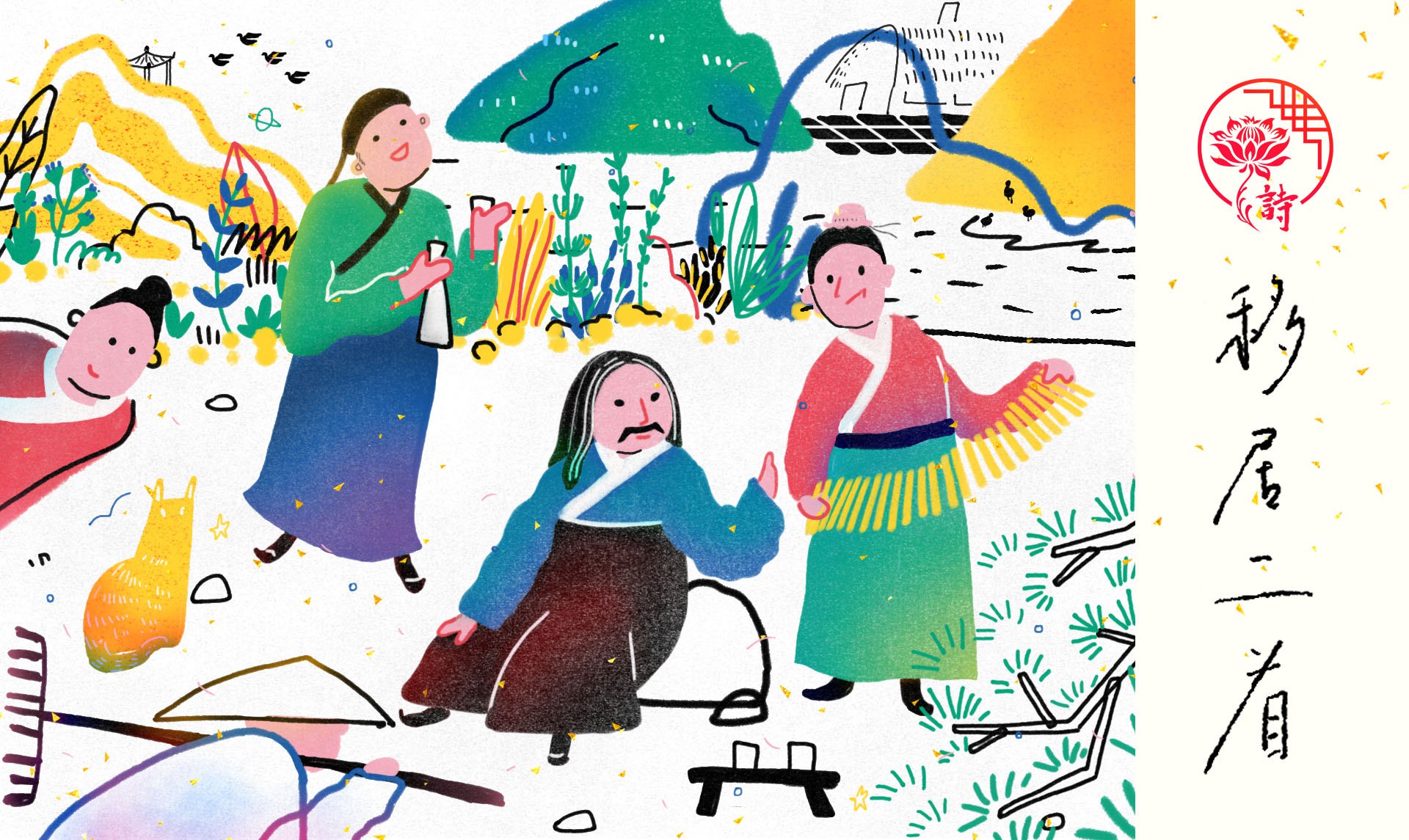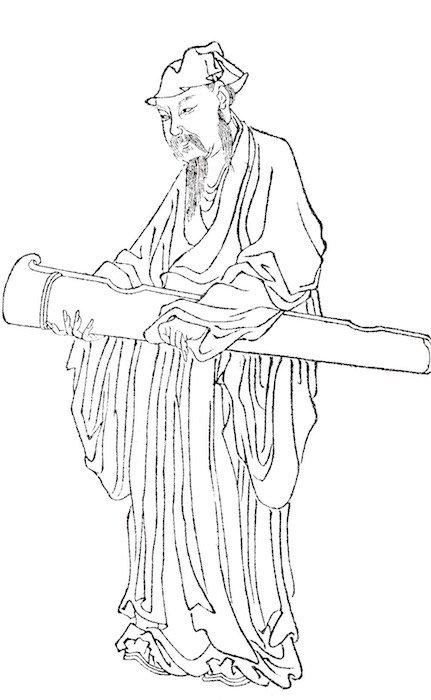Chinese poem - "Migration" - the joy of migrating to steemit 移居二首 陶淵明
Hi everyone! Thanks for dropping by to check out our first Tang poetry post. Tang poetry is the golden period of Chinese literature, and anyone who is studying or interested in Chinese literature will no doubt find it worthwhile to spend some time exploring it. Although Tang poetry dates back to over a thousand years, they’re actually not that old and stuffy and boring as you may think. Once you break it down, they’re quite easy to understand. They can be light hearted, fun and sometimes romantic, and often we can easily relate it back to our modern day life.
Today, we’re going to introduce the first Tang poem, explain what it means in plain English, and express it through contemporary music and artwork. But first of all, let me give you a very brief background on Tang poetry.
大家好,感謝大家點擊觀看我們的第一篇唐詩介紹!唐詩是中國文化的結晶,它是中國文學的代表,對每一位對中國文化有興趣的朋友,唐詩都是最值得欣賞和學習的。但不要因此而覺得唐詩會是古老而艱深的東西,它反而是一種很容易理解的文學風格。唐詩生動、浪漫、有趣,如果套用現代的環境,你更會發現唐詩敍述的故事其實與我們息息相關!
今天,我們將為大家介紹第一首唐詩,除了解釋這首唐詩的故事,我們還會以現代畫及音樂的方法去重新呈現這一首唐詩,但在開始之前,我們需要先說說唐詩的來源。

How did Tang poetry evolve? 唐詩是怎樣誕生的?
To understand the origins of Tang poetry better, we’ll quickly do a crash course on the history of Chinese poetry first.
Pre Tang poetry are known as ancient classical poetry versus neo classical poetry. The Classic of Poetry or the Odes are the oldest collection of Chinese poetry which dates between 11th to 7th century BC. Odes works are generally 4 word lines with no clear sentence structure, rhyme or tonal patterns. There are 3 main genres in Odes - Feng, Ya and Song - Tang Poetry is based on Feng which is folklore that reflects everyday life in society. Works in Odes are written in three main styles. Fu is a direct descriptive style, Bi is metaphor and Xing is where the author gets inspiration from his surroundings.
Fast forward to the 475 to 221 BC, Chu State was located around the central southern part of modern day China. Their poetry were rich in imagination and emotions, with a more liberated and disorder style of writing. Chu Ci is a collection of works from this period, and inspired the liberal and romanticism style of Tang poetry.
如果要探索唐詩的箇中趣味,首先要認識唐詩的起源。唐人將唐代以前的詩統稱為「古體詩」,而唐代的詩作則稱為「近體詩」。唐詩的雛型始於《詩經》三種體裁:「風」、「雅」、「頌」中的「風」。「風」即民歌,是寫實反映社會現況的作品。《詩經》的三種寫作手法:「賦」、「比」、「興」亦奠定了日後中國文學作品的常用寫作方式。「賦」即直接陳述、描寫、抒情;「比」即比喻;「興」即以景、物的聯想引起主題。《詩經》便是唐詩的最原始形態,以四言為主,並沒有明確的句式、押韻、用字等規範。
其後中國南方的楚國發展出具有地方色彩的文學作品,其中表表者便是屈原根據楚國用作祭神的民歌改編而成的「九歌」以及個人自傳式的「離騷」,從《詩經》的基礎上提供了更廣闊的體裁。作者在作品中表現出豐富的想像力,句式並非整齊,充滿浪漫與自由的風格。這便是《詩經》後的新型文體:《楚辭》,啟蒙了日後唐詩浪漫主義的寫作流派。
In the Han Dynasty (206 BC to AD220) the Music Bureau or Yuefu started their own collection of folksongs and ballads. Yuefu followed Odes tradition of a realistic approach, and a narrative style of writing was prominent during this period. Another major trend during this period was the change from 4 word to 5 word lines in the poems.
By the Wei Jin era in the 5th century, Gongti Poem was gaining popularity, but it is often described as more of style over substance. Poets were more stricter with the structure of their works, such as the inclusion of duality and rhythm. Gradually Gonti Poem developed into the orderly structure required by Tang Poetry.
And here’s our crash course on the history of Chinese poetry. So without further ado, let’s look at our first poem “Migration” 《移居二首》.
到了漢代,樂府(朝廷的音樂官署)效法《詩經》收集民間詩作民歌,繼承了詩經的現實主義和樸實自然的語言風格。樂府詩突破了《詩經》的四言句式,趨向五言,又發展了詩經的敘事元素而形成敘事詩。漢代的樂府掀起以五言為主的「齊言詩」的寫作熱潮,可謂唐詩的「五言絕詩」、「五言律詩」的「直系先祖」。
魏晉時期「宮體詩」興起,不追求詩句內容的實際,更著重形式的美。詩人開始在五言詩的基礎加上對偶、聲律、寫作手法的具體要求,於是宮體詩便漸漸邁向格律要求嚴格、句式工整的唐詩了。
希望以上的內容會讓大家對唐詩有更多的了解,現在正題終於來了!我們要介紹的第一首唐詩就是《移居二首》!

Starting from the basics
為什麼首先為大家介紹東晉五言詩《移居二首》? - 由淺入深

This is an beginner’s poem from the Dong Jin era in the 5th century (in the above we just talked about the Wei Jin era in the 5th century, these were turbulent times with many fragmented states). The words in the poem are relatively simple and concise, with a clear and neat structure, and many ending words that rhyme. Although the poem is not from the Tang poetry, many features are consistent with it. We also chose this poem because it aligns with our thinking on why we started this project.
歡迎進入詩的世界,為大家開始賞析唐詩之前,相信大家對上文所提及的「句式」、「押韻」、「對偶」等還未有清晰的概念。為了方便大家理解基礎的概念,我們先為大家介紹一首入門詩,這首詩用詞淺白易明,句數整齊,某些句子的最後一個音節都使用相同或相近的韻母,非常貼近唐詩的格式。
The poem is about the author moving to a utopia like village where he meets many like minded people, and spend their days drinking wine, appreciating literature, homesteading and enjoying life leisurely.
The Chinese Culture Project was born under similar circumstances. We realised there are a lot of like minded people here on Steemit who love poetry and literature, who are interested and open to learn more about different cultures, so this is a perfect platform for us to develop and promote our project.
We’re also quite similar to the poetic style of “Migration” as we’re still in our infancy and are still developing ourselves. We’re open to all feedback, criticisms and suggestions so we can better ourselves. We hope in the future we can start a Chinese version of Troubadour on Steemit where we combine classical poetry with modern music, so people can appreciate Chinese culture in a contemporary manner.
詩句描述的情景符合「樂筆詩塾」的創立理念
《移居二首》描述作者移居到世外桃源,並認識到一班志同道合的新朋友,閒時一起賞析詩歌文章,看似平凡的農莊主人也有著一顆文青的心。
「樂筆詩塾」同樣初來Steemit報到,發現Steemit擁有得天獨厚的先天條件,同樣是一個適合文化計劃持續紮根的好地方。
首先這裡有一群具備個人文化修養的用戶,他們謙虛有禮、他們追求知識、他們學識淵博⋯⋯
此外Steemit的平台受眾廣闊,除了CN區抱團取暖的華人,還有對博大精深的中國文化深感興趣的外國朋友。「樂筆詩塾」就像<移居二首>這首「五言詩」,不像唐詩擁有明確既格律、句數與對偶要求,僅僅屬於建構雛型的階段,需要大家的提點與體諒,作出更完善的改進。「樂筆詩塾」希望在不久的將來可以擔當拋磚引玉的角色,像歐洲中世紀的遊吟詩人(troubadour),在Steemit這個平台重新流傳舊詞新曲,再度掀起當年方文山與周杰倫以中國詩詞入曲的熱潮。外國友人透過吟唱由我們成員重新編上曲調的詩句,觀賞我們成員為每首作品親筆繪畫的精美插圖,以有趣生動的方式從聽覺與視覺一起品鑒中國的文學作品,認識中國文化。
The background 《移居二首》的創作背景

Tao Yuanming 陶淵明 (photo from Wikipedia)
“Migration” was written by Tao Yuanming, believed to have lived around 365 - 427. He was a government official but didn’t like the rat race and the politics that came with the job so he resigned and went to live in reclusion in the countryside for most of his life. His daily life consisted of writing poems and drinking wine with his like minded neighbours and farming to ensure sustainability.
作者陶淵明是東晉末期南朝宋初期詩人,曾經做過地方小官,後來無法忍受官場黑暗,決定隱居田園,過著自給自足、崇尚自然的農耕生活。他有著一個優雅又不失低調的外號:「隱逸詩人之宗」,他追求精神自由,因而選擇了放棄官位提早過著退休生活。那種淡泊名利的瀟洒,絕對是後世歸隱田園的文人的效法對象。
關於陶淵明歸隱田園時過的生活水平到底是貧是富,他的真正身份是農民抑或地主,坊間一直存有討論。可以肯定的是陶淵明是一個真正喜愛自然生活的知識分子,能夠真正做到心如止水、不問世事的境界。

The composition <移居二首> 譯文
The poem consists of 24 lines. We have broken it down to six four line blocks to make it easier to explain.
為了方便大家理解詩句的意思,我們將每四句劃分為一個層面,並加上小標題概括大概的意思。
How the idea of migration started 移居的念頭由來
昔欲居南村,非爲卜其宅。 xī yù jū nán cūn , fēi wéi bǔ qí zhái
聞多素心人,樂與數晨夕。 wén duō sù xīn rén , lè yǔ shù chén xī
Previously thought about moving to the South Village, not because there were nice houses, but because the South Village has many pure minded people whom I would be very happy to acquaint many days and nights with
從前想移居到南村,並非爲了挑選那裡好的宅院。
聽聞南村有許多心思純樸的人,我樂意與他們度過無數個早晚。
Migration becomes a reality 移居的夢想實現
懷此頗有年,今日從茲役。 huái cǐ pō yǒu nián , jīn rì cóng zī yì
敝廬何必廣,取足蔽牀蓆。 bì lú hé bì guǎng , qǔ zú bì chuáng gào
I have thought about this for many years, finally it has become a reality today. The house doesn’t need to be grand or big, as long as it can fit in a bed.
這個念頭存於心底已有多年,今天總算辦完這件事情。
簡樸的屋子何必追求廣闊,只要夠擺牀鋪就心足了。
The cultured life - reading and writing 移居的文青生活 - 讀書會
鄰曲時時來,抗言談在昔。 lín qū shí shí lái , kàng yán tán zài xī
奇文共欣賞,疑義相與析。 qí wén gòng xīn shǎng , yí yì xiāng yǔ xī
My neighbours and friends often come around, we talk happily and freely about yesteryears. When we discover a good piece of work, we appreciate it together, when we come across any problems, we solve it together
鄰居朋友經常前來我的家裡,暢所欲言地談論往日的事情。
讀到好文章時,大家會一同欣賞;遇到疑難處時,大家一同鑽研分析。
The cultured life - leisure and drinking 移居的文青生活 - 郊遊、飲酒
春秋多佳日,登高賦新詩。 chūn qiū duō jiā rì , dēng gāo fù xīn shī
過門更相呼,有酒斟酌之。 guò mén gēng xiāng hū , yǒu jiǔ zhēn zhuó zhī
Spring and autumn are the good times to go hiking and recite poems up in the mountain. When we pass by each other’s houses, we will arrange a date and fine wine to spend quality time together
春秋兩季有很多好日子,我經常同友人一起登高吟誦新詩篇。
經過門前互相招呼,相約聚會,準備好酒一起同飲共歡。
The cultured life - farming and discussions 移居的文青生活 - 忙時種田、閒時聊天
農務各自歸,閒暇輒相思。 nóng wù gè zì guī , xián xiá zhé xiāng sī
相思則披衣,言笑無厭時。 xiāng sī zé pī yī , yán xiào wú yàn shí
When working on our farmland alone we miss each other’s company. When we miss each other’s company we grab our coat and go and visit one another. We shall never get bored of each other’s laughter
要幹農活便各自歸去,閒暇時馬上互相思念。
思念的時候,大家就披衣相訪,談談笑笑永不厭煩。
The apperception of migration 移居的領悟
此理將不勝?無爲忽去茲。 cǐ lǐ jiāng bù shèng ? wú wéi hū qù zī
衣食當須紀,力耕不吾欺。 yī shí dāng xū jì , lì gēng bù wú qī
This kind of life is absolutely delightful, and there is no reason to give it up. Everything I wear and eat is created by myself. If you work hard enough to provide for yourself, you will be able to reap the rewards.
這種飲酒言笑的生活的確很美好,沒有理由要拋棄這樣的生活。
穿的吃的需要自己親自去經營,應當自食其力,努力耕作必有收穫。

The poetic structure of Migration 《移居二首》的格律特點
Sentence 句式
The poem has 24 lines, each with 5 words, this type of orderly structure poem is called Five Words Poetry. Apart from looking neat and tidy when written, reciting Five Words Poetry has a very nice rhythm. You can listen to it on our composed piece of music and maybe even try to sing along and see for yourself. In future, we will elaborate more on Five Words Poetry.
全詩共二十四句,每句都是非常整齊的五字。五字一句的詩,統稱為「五言詩」。整齊的句式,除了看起來更工整,在朗讀吟唱時亦更有節奏感,大家不妨可以按照我們的編曲嘗試模唱。日後介紹唐詩時,將會再深入講解「五言絕詩」與「五言律詩」的概念,在此讓大家先認識最基本的「五言詩」。
Rhythm 押韻
Rhythm requires that the last word in each line has the same or similar finals. In Tang poetry the rhythm occurs in alternate lines, but in in Five Word Poetry it is less well defined. In Migration, we can see the beginning of how rhythm is built into the structure. Apart from the last word in lines 2 and 24 that don’t rhyme, all the last word in lines 4, 6, 8, 10 and 12 have the same final “ik” in Cantonese or “xi” in Mandarin, while in lines 14, 16, 18, 20 and 22 the last word all have the final “i”. This poem is a good example of rhythm in Chinese poetry.
「押韻」的意思是句子的最後一個音節都使用相同或相近的韻母。「唐詩」要求雙數句子的最後一個字押韻,而五言詩未有明確限制,但大家細閱<移居二首>的雙數句子的最後一個字,可以發現已經有嚴謹的押韻。除了第二句的最後一個字「宅」、最後一句的最後一個字「欺」並非同韻,詩的前部份「夕」、「役」、「蓆」、「昔」、「析」都是以粵音「ik」、普通話「xi」為韻母;詩的下半部「詩」、「之」、「思」、「時」、「茲」都是以粵音「i」、普通話「i」為韻母。兩者韻母相近,可以說整首詩是一首講究押韻的作品。
Highlight from the poem 精選句子分享:
奇文共欣賞,疑義相與析。 qí wén gòng xīn shǎng , yí yì xiāng yǔ xī
When we discover a good piece of work, we appreciate it together, when we come across any problems, we solve it together
When reading these two sentences you may wonder why a group of farmers have so much interest in literature and culture. Were farmers in the old days all so well educated like Steemians are today? Well, this is all down to the South Village where Tao choose to live in recluse. The residents there weren’t all normal farmers, many were actually intellectuals like Tao who were fed up with the political struggles within the government and retreated for a peaceful life. This is quite similar to the French nobles who retreated to their Bordeaux vineyards, and spent their days tending the vines, making wine and appreciating art and culture.
Where there is no conflict of interest, scholars love to reminisce the good old times together, talk freely without fear of condemnation and seek to exchange thoughts at the intellectual level. Likewise,, the Chinese Culture Project want to provoke interest and promote cultural exchange with Steemians.
大家看到這兩句時,應該會感到非常疑惑與驚訝,為什麼一群農民會產生舉辦讀書會的想法呢?難道古代農民的文化底蘊已經達到通曉詩詞的Steemit級水平嗎?這裡要跟大家說明一個概念,在作者陶淵明選擇隱居的南村,住著的並不只有農民,還有跟作者一樣因厭惡官場而選擇隱居的讀書人。情景就像一群歐洲貴族隱居在波爾多偏遠的莊園,平時修剪葡萄園的枝葉,閒時舉行聚會,一邊從酒窖取出紅酒暢飲,一邊暢談古今藝術作品,這是一種高尚的生活品味。這樣的比喻應該能令大家更理解一群「農夫」聚在一起賞析文章的獵奇畫面了。
讀書人的特點和愛好便是一起回憶往事,在毫無利益衝突的關係中,大家可以無拘無束、毫無保留地交心。於是他們可以風花雪月,一起欣賞奇文,共同分析疑難的文義,暢遊學海,追求精神上的交流。同樣地,「樂筆詩塾」也希望跟大家「奇文共欣賞,疑義相與析。」,日後可以跟廣大的Steemit朋友們有更多的精神交流。

Now we understand this poem more, let’s move on to the contemporary music and art sections. If you can’t watch Dlive, you may watch our music video through Youtube
現在,我們將嘗試利用現代畫作及現代音樂的形式去全新演譯《移居二首》,如果你看不到Dlive,也可從Youtube欣賞我們的音樂視頻。
The music section is composed and arranged by @kona using the Vocaloid software. The first part of the Cantonese vocals are sung by @tine and the second part in Mandarin by the virtual singer Miku V4. In future we hope we can add a singer to our team.
Tang poetry is a genre of poetry with its own characteristic and rhythm, so naturally can be composed into a song. The first 12 lines is the verse and the last 12 lines is the chorus. In the first 8 lines of the poem, Tao has escaped from the institution and is looking for his utopia. Likewise Steemit is a decentralised platform where we can create our own path and future. We have chosen this platform to launch the Chinese Culture Project, just as Tao has chosen to live in South Village. Lines 9 to 12 is about how Tao starts his new life, and here we are taking our first step into our new venture. Lines 13 to 24 is the chorus and is about Tao’s daily life and time spent with his new found friends. We all spend a lot of time on Steemit, sharing and networking with one another, sometimes even forgetting about work or family. The bottom line is that we all enjoy the time spent here, why would anyone want to abandon this platform. Finally, although the team has spent a lot of time working on this post, we believe our effort will not go to waste and one day we shall be rewarded with your appreciation and support.
The beat of the song takes a rather sombre tone which reflects our current mood. We’ve found the perfect platform to launch our project, but we’re not sure what the reaction will be. Everything is a bit uncertain at the moment. All we can do is wait and see. However, we are confident of our project and hope you will like what we do here.
在音樂製作的過程中,我們邀請了@tine為我們演唱歌曲開頭的粵語段落,而在後段的國語段落,我們使用了初音未來 - 世界第一個虛擬歌手系統來為我們演譯這首歌曲,在未來,我們亦很希望會有一位擅長歌唱的朋友能夠加入我們,親自演譯我們的歌曲。
唐詩是詩歌的體裁之一,自然可以配上音樂編成歌曲。歌曲以詩歌的頭12句作為正歌部份,頭8句把我們欲求的網上社交平台的心能表達出來,我們是去中心化的支持者,一直希望找到一個理想的社交平台能讓我們分享生活、創作,這個平台找到了,就是Steemit,就正如作者找到他的南村一樣。第9-12句開始了作者在南村的生活,就如我們開始了Steemit的分享,為大家分享中國詩歌,作為進入副歌的過渡。
詩歌的13-24句就是副歌的部份了,這裡敍述了作者在南村的生活,就如我們在Steemit,每天分享文章,在朋友的文章留言交流,工作的時候彼此工作,工作結束後又急不及待回到
Steemit,相約談笑。詩歌的最後4句亦表達了我們的中心思想:既然找到一個理想的平台,為何要拋棄?正如《樂筆詩墪》,雖然一篇唐詩的介紹花費我們很多時間,但我們相信我們的努力,在Steemit這個平台能得到收獲。整首歌的編曲風格偏向低沉,這也是《樂筆詩塾》現在的心情,我們雖然找到了一個很好的平台,但我們仍未知道大家的反應,仍是感到未知、迷茫,但我們對《樂筆詩塾》仍然感到期待,因為我們相信,你們會喜歡的我們的分享。

In the sketch Tao Yuanming is enjoying his peaceful life at the countryside in South Village. There’s a small temple on the left, typical of ancient Chinese landscape. His humble abode is on the right hand side. Tao is with his friends, one has a bottle of wine and another has a bamboo scroll, together they’re appreciating the poetry. This reflects the highlighted sentences from this poem “When we discover a good piece of work, we appreciate it together, when we come across any problems, we solve it together”. Another neighbour has come back from working in the fields, rake on shoulder and has dropped by to join them “When we pass by each other’s houses, we will arrange a date and fine wine to spend quality time together”
畫中呈現出一個寧靜的村落,左面背景是一座山,山上有一座小廟,這是中國畫常見的景象。右面背景我們看到房屋,正代表作者已搬到南村來了!
圖中心坐在石上的正是作者陶淵明,他左邊的友人手中拿著的黃色一條條的是竹簡,一般以竹製作,古人用毛筆把文字寫在竹上以紀錄文字,是中國古代的文字截體,這名友人明顯正與作者一同讀文,應了「奇文共欣賞,疑義相與析。」一句。
作者右手邊的友人手中拿著酒和杯,看來正準備與作者大酌一番了,旁邊拿著犁耙的農夫和其他村民都被吸引來了,正是「過門更相呼,有酒斟酌之。」!

We want to thank you for reading our post and making it to the end. It’s our first ever poem that we done in this format. We’ve poured our hearts into it and we know its not perfect so we don’t expect a big round of applause. But we really would love is your honest feedback, criticism and or anything that we’ve overlooked, is unclear or can be improved.
In Hong Kong were we all live, spring is already here and the four seasons are always a favourite topic for Tang poems. In the next post, we will introduce a poem related to Spring. We hope you will come and join us then. Till then, take care.
謝謝大家能夠堅持看完整篇文章,作為啟首第一篇,我們不求大家的讚賞,但希望大家能夠給予我們意見、提點,給我們知道自己沒有留意的地方,加以改善。
在我們居住的城市香港,春天來臨了,而四季,正是唐詩一個很熱門的題材,所以,我們將會在下一篇介紹一首關於春天的唐詩,請大家熱切期待!
Production Team 製作團隊
Literature Guide 導讀: @perlia
Literature Translation 詩歌解析: @perlia
Music 音樂: @kona
Art 插圖: @nanosesame
Video 視頻: @aaronli
English Editor 英語編輯: @livinguktaiwan
Chinese Editor 中文編輯: @aaronli

My video is at DLive
如斯好文 当浮一大白
嘩當浮一大白是什麼意思?你比我們更厲害XD
内容好赞,佩服佩服!
謝謝讚賞!
I can see all the hard work that you are doing and that this develops, thanks for sharing!
Thank you for reading, pls free feel to give us some advise👏👏
非常专业👍
謝謝你啊~
Woohoo 🙌 the baby was born~ Congrats! Great job. 👏 Interesting to see the combination of Cantonese singing voice and Pinyin - a creative try!
Thanks for your support!
下次幫你的小蝌蚪編首曲
Great work guys! So much effort put in 👏👏👏
Thank you @travelgirl! Appreciate it!
太犀利咗,无得定!
頂!
哇这就是我想做的中英内容嘛~~不过真的需要一个团队呢,我一个人做不下来
對呀,不是一個團隊真的做不來!
可以申请远程入伙吗哈哈哈~
这么多个tag是怎么办到的啊?
用dlive upload就可以了
明白了,Thanks♪(・ω・)ノ
中英文詩詞翻譯!不得了的內容!⭐️⭐️⭐️
謝謝到此一遊😎😎